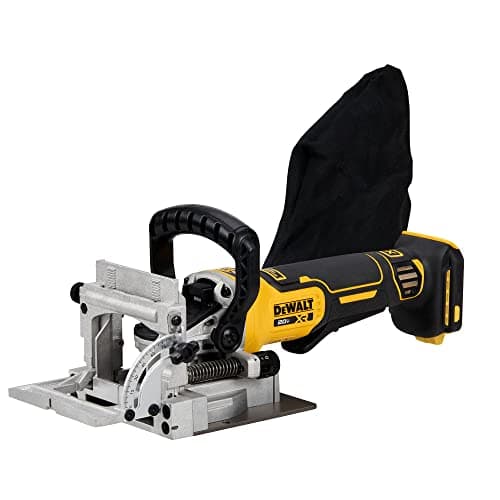
Power and speed are the two paramount attributes of any biscuit & plate joiner you might be considering. They're essentially the engine of the tool, directly affecting the quality of your work and productivity. Power, measured in watts or amps, dictates how smoothly and efficiently your joiner can slice through material. A more powerful motor will ensure that the joiner remains consistent, even when working with tough woods, reducing your fatigue and increasing productivity.
Speed, on the other hand, is measured in RPM (rotations per minute). It represents how fast the cutting blade spins. A faster blade not only means quicker work but also cleaner cuts. High speed can minimize tear-out and make for a neater, more professional result. Just remember that high power and speed doesn't always equate to a better tool. It's important to find a biscuit & plate joiner that strikes a balance between power, speed, and controllability to match your specific needs and skill level.
Conversely, a cheaper option may seem appealing initially, but it might not be as cost-effective in the long run, especially if it's not durable, lacks vital features, or doesn't perform as well. It's about finding the balance between what you're willing to spend upfront and the kind of value you want from your joiner in terms of its functionality and longevity. So, when you're at the checkout page, don't just look at the price tag, think about the value the joiner offers in the long-term.
When it comes to biscuit and plate joiners, there are several top-tier brands that stand out from the crowd, each of them boasting a unique blend of functionality, build quality, and value. Let's dive right into a few of these standout names. At the forefront, you have DeWalt, a household name in power tools whose joiners are lauded for their reliability and impressive power. They offer a range of models to cater to all levels, from the casual DIY enthusiast to the professional carpenter.
Next up is Porter-Cable, another leading brand known for their high-quality, durable joiners. Many users praise Porter-Cable joiners for their precise cuts and easy-to-use features, making them an excellent choice for both beginners and experts alike. Then there's Makita, a brand that's gained a reputation for producing high-performance, long-lasting joiners. Makita's joiners are often noted for their user-friendly design and remarkable cutting accuracy.
Last but not least is Bosch, a brand with a rich history in the power tool industry. Bosch joiners are celebrated for their robust construction and innovative features, ensuring a seamless joining experience. Each of these brands offers a unique spin on biscuit and plate joiners, ensuring that you'll find the perfect tool to meet your specific needs and budget.
Let's dive into some of the most frequently asked questions concerning biscuit and plate joiners - the unsung heroes of carpentry!
Q: What are biscuit and plate joiners used for?
A: Biscuit and plate joiners are used to combine two pieces of wood together. They cut slots into wood, which then hold specially-shaped 'biscuits'. When these biscuits are coated with glue and inserted into the slots, they expand, creating a strong, tight joint.
Q: How do I choose the right joiner for my needs?
A: When choosing the right joiner, consider the size and depth of the cuts you'll be making and the type of wood you'll be using. If you're working with harder woods, you'll need a joiner with more power. For larger projects, a joiner with adjustable depth settings would be beneficial. It's also crucial to consider the build quality and the brand's reputation for durability and performance.
Q: Are more expensive joiners necessarily better?
A: Not always. While it's true that higher-priced joiners often come with more features and are generally more durable, budget options can still deliver excellent results for hobbyists or occasional users. Do remember that a joiner is an investment, so it's crucial to balance price with the tool's potential longevity and your specific needs.
Q: Can I use a joiner for materials other than wood?
A: Generally, joiners are designed for use on wood. However, some high-quality joiners can handle composite materials. Always check the manufacturer's guidelines before trying it on non-wood materials to avoid damaging the tool.
Q: How do I maintain my joiner?
A: Regular cleaning, proper storage, and timely blade replacements are key to maintaining your joiner. It's also a good idea to occasionally check for loose screws and ensure the power cord is in good condition. Regular maintenance will extend the life of your joiner and ensure it remains reliable and efficient.
As we wrap up our buying guide, it's clear that biscuit & plate joiners are a staple tool for any serious woodworker. These devices not only streamline construction but also create more durable and cleaner-looking joints. But like any tool, what works best for you will depend on your specific needs and preferences.
For those who prioritize power and speed, opt for models with high amps and RPMs. Keep in mind, however, that more power might mean a heavier, bulkier tool. Don’t forget to consider the size of the joiner, as you'll need a tool that's easy to handle and maneuver, especially for intricate projects.
Material and build quality should be a key consideration, as this will determine the durability and lifespan of your joiner. Remember, an inexpensive tool might not be a value buy if it falls apart after a few uses.
When it comes to brands, you can't go wrong with the industry classics like DEWALT, Makita, and Porter-Cable. These manufacturers have earned their reputation for consistently delivering high-quality, reliable tools. If you're unsure about a certain model, reading reviews and FAQs can give you a deeper insight into its performance and value.
Lastly, remember that the best biscuit & plate joiner is the one that suits your specific needs and budget. Happy shopping and happy woodworking!




